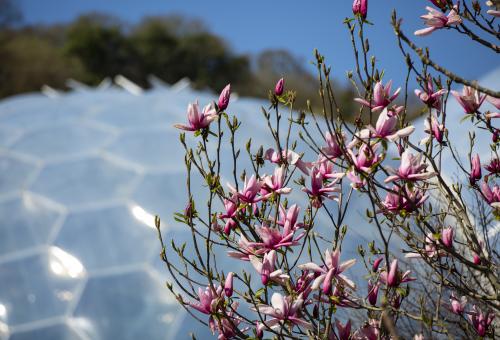Make a pledge, keep climate positive
You have the power to make a difference to the future of our planet and all that call it home. From recycling and reusing, to growing your own food – there’s so much you can do. What will you pledge?
We’re closed some weekdays until 12 February, for essential maintenance. Check our opening times before booking.
Did you know that plants like magnolias and ferns were around when dinosaurs roamed the Earth, surviving mass extinctions?
Their fossils have been found across the world – and we have living examples of them at the Eden Project.
Aristolochia gigantea
These plants with their scrambling leaves and massive drooping flowers were around when dinosaurs roamed the earth. In the Cretaceous period (142 -65 million years ago) the early flowers had arrived, with many pollinated by insects too – just like flowers today. The Aristolochia’s smelly flowers attract flies, which get trapped inside and covered in pollen before the flower lets them out. Once used as medicines in Brazil, these types of flowers are now known to be poisonous!
Dioon spinulosum
The cycads and their look-alike ancestors have been around 280 million years and have survived several mass extinctions.
Piper nigrum
The first ancestor fossils of the pepper family were found in Colombia. These fossils originated from way back during the Cretaceous period (145–100 million years ago). After the dinosaurs died out plenty of new things happened to the world's climate, affecting places all over the world. In South America, the Andes mountains grew up, while the Amazon rainforest first sprang into being, and lots of different pepper species eventually started to grow and grow.
Platycerium bifurcatum
Surprisingly, these ferns never actually needed soil to grow. Instead, they clung to rocks (and to big trees today) and made their own soil as old leaves died. Naturally occurring from Indonesia, and grown in places as far as the coastal regions of New South Wales in Australia, this ephiphyte plant has a dramatic exotic appearance, as well as being widely used today in tropical gardens.
Davallia solida
This Australian fern is named for its furry ‘feet’ at the base of its stems!
Protea cynaroides
Plants in this family are found in South America, South Africa, Australia, and New Zealand. Some of these plants’ ancestors date back 65 million years to when South Africa was a tropical forest.
Elegia capensis
These plants were around in the late Cretaceous period (145–100 million years ago) and grew in Gondwana, which was one of the supercontinents that made up the earth millions of years ago. This type of plant could well have been a tasty snack for the Ankylosaurus and Triceratops.
Calycanthus occidentalis
This interesting looking flower was also around at the end of the Cretaceous period and smells a bit like bubblegum. It's used in some perfumes and, despite its name, is actually poisonous.
Blechnum spicant
Ferns like this have been around for up to 350 million years – that's way before the dinosaurs! These ferns were one of the first big plants to live on land and helped make oxygen, which made the land ready for other life to start living too.
Cycas revoluta
Ancestors of this plant were around 270 million years ago, even before the dinosaurs ruled the earth. Like lots of other plants, this one is very, very poisonous. If it's eaten, it's even likely to cause death.
Magnolias and their close ancestors were around in the Cretaceous period (142 to 65 million years ago). These plants were around before bees existed so beetles pollinated them instead.
Dicksonia antarctica
These ferns come from Australia and can reach 15m in height. However, they still weren't tall enough to keep out the way of the big plant-eating dinosaurs. The big veggie dinos chomped through about 500kg of plant material a day.
Wollemia nobilis
Fossils of this prehistoric tree showed it was around in the Jurassic era, 200 million years ago, when Stegosaurus and Iguanodon roamed the earth. Scientists thought it was extinct. In 1994, David Noble, adventurous rock climber and forest trekker, spotted an unusual plant in a very remote spot of temperate rainforest in New South Wales, Australia. It was identified as a Wollemi pine – it wasn't extinct after all!
Metasequoia glyptostroboides
Although the one at Eden is only a baby, these trees can grow to a height of 60m – that's higher than our Rainforest Biome! The T. rex walked among these giants back in the late Cretaceous period 67 million years ago. The trees were thought to be extinct until, in the 1940s, explorers found a whole forest of them in China.
Ginkgo biloba
This tree is sometimes called a 'living fossil'. Fossils of its ancestors go back 270 million years to the Permian times when trilobites were alive. It almost became extinct in the wild, but was luckily maintained in Chinese monastery gardens – so we still have it today.














